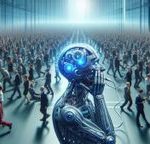The victory of the Alternative for Germany (AfD) party in the elections last Sunday, in the Sonneberg region, east of the country, puts the extreme right at the center of the German political debate. Its growth in polls at the regional and federal level shows a significant mobilization of people who express their discontent, but at the same time their eventual tolerance for radicalized options that promote anti-democratic narratives. Are we facing a new era in Germany?
Last weekend the second round of a communal election was held in a small region of Thüringen, a German region in the east of the country. The result shocked the German political world: the candidate of the far-right Alternative für Deutschland (AfD) party or Alternative for Germany, Robert Sesselmann,He was victorious in the second round and was elected as “Landrat” (regional administrator) in Sonneberg.
It is the first time that this has happened in the nation and despite the fact that it is a very small district, the symbolic impact is enormous. Has the AfD crossed the threshold of normalization and will it be accepted as a force within the democratic spectrum despite its more radical expressions? Will it be the beginning of a formal normalization process, at least in the east of the country, that will allow the radical right to reach agreements with other parties and obtain real shares of power?
The questions are multiplying and for the political parties in Germany the challenge is enormous. Not because the AfD has won in that region, but because at the federal level, according to what the polls indicate, the far right fights for second place.
The German far-right soars in the polls
The party of the German radical right has already two months above 15% in voting intention. A high number for the parliamentary context in Germany that requires forming coalitions between parties to achieve majorities and to form a government.
In other words, the ability to condition the formation of government coalitions is enormous, since it forces alliances between three and up to four parties, which makes them less stable and feeds a key element in the AfD’s discourse: all the “other” parties. They are the same.
However, in recent days that number has grown by more than 20%. According to a measurement by INSA Consulere, AfD would receive 20.5% of the votes and with this it would be located above the social democratic party (SPD) of the current chancellor Olaf Scholz.
?? Germany’s far-right AfD won its first district election Sunday, a further boost to the anti-immigration party as it surges to record highs in opinion polls. pic.twitter.com/8w84N6fs2Z
— FRANCE 24 English (@France24_en) June 26, 2023
The most interesting thing about the work of this pollster is observed in another data that they publish regularly and is related to the rejection of the political benches. To measure this, the following question was asked of the respondents: “Which of the following parties can’t you imagine voting for?” Exactly 4 years ago, in June 2019, the AfD received 70% rejection. By far the least loved party of those with representation in the Federal Parliament. Today that rejection is much less and only 54% cannot imagine voting for the AfD.
These data, added to growth of voting intention in the east for the next regional elections, they state that the AfD is gradually managing to normalize itself and become one more option. Something unthinkable in Germany just a few years ago. The extreme right of the country then enters a new stage.
AfD strengthens in the heat of political and social discontent
Ten years after its founding, Alternative für Deutschland is entering a third phase marked by a normalization process that is fueled by the low popularity of the current federal government and the use of its narrative by certain sectors of the opposition.
Indeed, the leader of the FreieWähler (FW), Hubert Aiwanger, who co-governs with the Christian Social Union (CSU) in Bavaria, stated a few weeks ago that “We have to recover our democracy”. A phrase aligned with the expressions of the populist radical right that criticize democratic institutions and express their distancing from a supposed general will of the people.
The first phase of the AfD had the Euro crisis as the protagonist. In fact, on this question he coined a novelty for Germany in 2013: the eurosceptic discourse.
After a few years, a second phase in the life of this party took shape around the humanitarian crisis due to the arrival of thousands of refugees towards the end of the summer of 2015. A debate that, added to the attacks in France, Spain and Germany, allowed the far-right force into the Bundestag in 2017.

Subsequently, the internal fights and its inability to lead the anti-government and anti-scientific discourse in times of pandemic, as other radical right-wing parties in the world did, slowed down its growth and placed it at around 10% intention to vote. vote. A kind of stagnation in which its most radicalized sectors were gaining even more space, despite losing some prominence in the public debate.
The third phase of the AfD returns that role to the extreme right. Not only is it characterized by a sharpening of its fundamental opposition role, but it is marked by the negative consequences in Germany of the invasion of Ukraine, the energy crisis, its inflationary impact and the lack of clear prospects for its completion, generating a climate of ideal uncertainty for the ultra-rightists to sow fear.
Indeed, one of the concepts that they appropriated almost alone, Sahra Wagenkneckt of the post-communist left, comes pretty close to that idea. peace”. While the rest of the parties discuss the shipment of weapons to Ukraine with the aim of protecting democratic values and preventing the growth of the power of the Government of Vladimir Putin, AfD demands an end to the conflict at all costs. What they do not explain are the negative consequences of a complete collapse of Ukraine and the threat that this represents for the European Union (EU) from every point of view.
The challenge of political parties
The scenario represents a problem for German political parties. Those in government (Social Democrats, Greens and Liberals) must continue to take charge of the effects of your decisions in a negative economic, social and political context.
Their internal discussions are seen as strong signs of instability and with them they feed the fear of inflation, recession and, above all, losing a certain standard of living, whatever the sector.

In this context, the natural thing would be for an opposition that outlines its alternative and political project to compete to replace the current coalition. However, that profile is not so clear. And the criticism comes from within.
Daniel Günther, minister-president of Schleswig-Holstein, a federated state in the north of the country, and a well-known figure of the Christian Democratic Union (CDU) expressed in recent days the need to offer a central discourse that does not get lost in “shocked secondary issues”.
And then he added a key phrase: “We are currently failing to convey to people what we would do differently.” This phrase from Günther reflects a need, not only for his party, but for the entire democratic political spectrum. It is a matter of accounting for the existence of competing projects that can provide concrete solutions and not anti-democratic and reductionist narratives.












